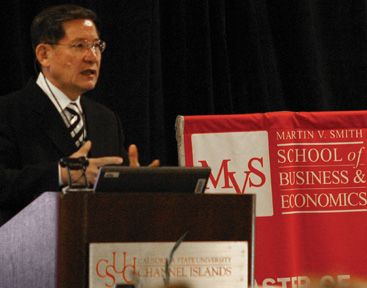The Shape of the Recovery
By Lori Putnam

Cycles in the economy, like letters in the alphabet, come in different forms. Some cycles drop sharply and rise rapidly, resembling the sharp angles of the letter v. Others offer more gentle slopes, like those of the letter u. And still others resemble the letter w, giving investors a roller coaster ride of double dips.
The latter, a double recession, was last seen in 1980 and 1982. Noted economist and Endowed Professor for the Martin V. Smith School of Business & Economics, Dr. Sung Won Sohn, suggests we may be headed that way again.
Last fall, when the financial markets were holding their collective breath, Dr. Sohn presented his first economic address to the CI community. A year later, with Lehman Brothers just a memory, Dr. Sohn shared his findings again to a large audience gathered to hear from the one person the Wall Street Journal has touted as the most accurate economist in the U.S.
Forgetting the Fundamentals
“Clearly students should understand what went wrong and what lessons we had forgotten since the last financial crisis in the 30s,” says Sohn when asked what CI students can take away from the events of the past year. “The next thing to learn is what do we do to prevent a similar crisis in the future.”
Sohn credits the unraveling of the economy to a confluence of events including subprime loans, securitization, a subsidized housing market, and CEOs who just weren’t paying attention to financial fundamentals.
Although Sohn sees some reasons to be optimistic, he warns of a weak dollar and America’s eroding position as an economic powerhouse. “Twenty years ago we could dictate economic policy, but today the value of the dollar is plunging. China is the economic power,” warns Sohn. “We have to pay a lot of attention to them. We are borrowing $3 billion every day, a significant portion from the Chinese and Arabs.”
Fireman’s First Rule: Know Your Way Out
According to Sohn, the economy will have contracted 2.9 percent by the end of 2009. He predicts it will expand by two percent in 2010. While Sohn commended the actions of Federal Reserve Bank Chairman Ben Bernanke for putting money into the economy to avoid a depression, he sees a troubling recovery ahead.
“We’re not out of woods yet,” warned Sohn. “The jobless rate is 9.8 percent in the U.S.—12.2 percent in California—and is headed higher. Consumers account for 70 percent of the economy, so when there are no jobs, we as consumers can’t spend. We don’t feel confident to buy items based on credit.” And credit is like oxygen for the economy, observed Sohn. Other concerns that top Sohn’s list of worries include the end of stimulus money, a problematic monetary policy, and an ailing commercial real estate market.
The key is knowing how to find our way out of this crisis, said Sohn, since the traditional approach by government to increase regulation doesn’t work. “We need new and innovative ways to both run and regulate business today.” But he made clear that no one person holds the solution for a strong recovery. “I wish I could say I had the answers here,” said Sohn as he tapped his suit pocket. “But I don’t. And I don’t know if I would give them to you if I did.”
Beginning January 2010, Sohn will be leading a series of seminars on current events in business including healthcare reform, the Federal Reserve, Social Security, and more. To learn more about Dr. Sohn, visit www.DrSohn.com.
